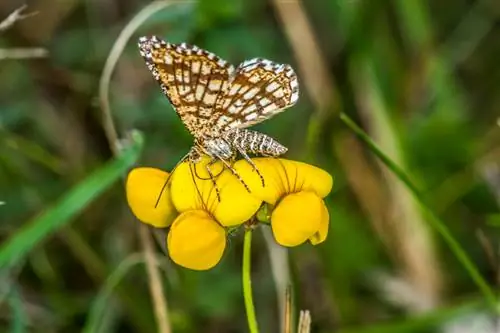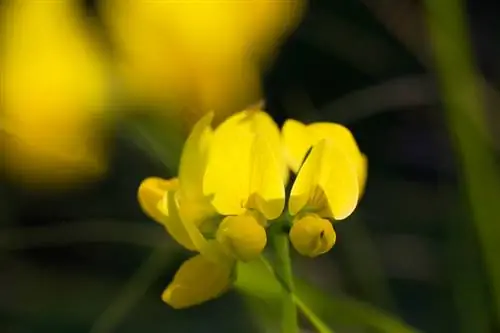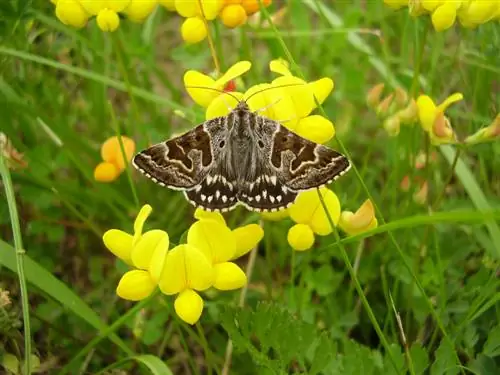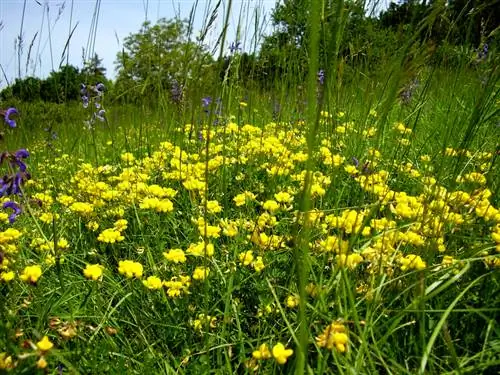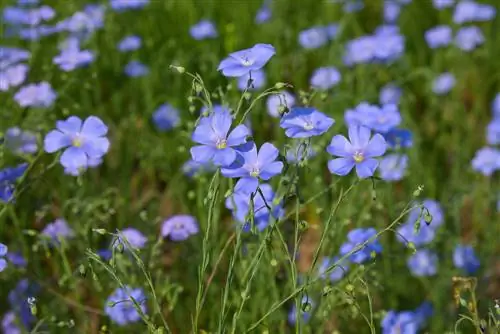- Author admin [email protected].
- Public 2024-01-10 23:11.
- Last modified 2025-01-23 11:22.
Opinions differ when it comes to horn clover. Popular as a distinctive perennial in the natural garden and in the midst of colorful flowering meadows, lotus is fought vehemently in the lawn. The following answers to frequently asked questions shed light on all aspects of meadow trefoil and provide useful tips.

How to care for horn trefoil in the garden and in pots?
Horn clover is a decorative small perennial with yellow butterfly flowers that can be cultivated in beds as well as in pots and balcony boxes. Care includes regular watering, fertilizing and cleaning out withered flowers, while hardy species remain outside and frost-sensitive species overwinter in cool, bright rooms.
Planting horn clover correctly
So that meadow horn clover fulfills its intended task in the garden to your complete satisfaction, the following aspects must be taken into account when planting:
- Make small pits 25 cm apart in a sunny spot with sandy-loamy to gravelly soil
- If necessary, enrich the excavation with sand or fine grit
- Unpot the water-soaked root ball, plant up to the lower pair of leaves and water
To properly plant a type of lotus in a pot and balcony box, create drainage underneath the substrate to prevent waterlogging. To do this, spread pottery shards or grit over the water drain before filling in the potting soil. The planting distance in the container can be 10-12 cm, because here the long tendrils dangle casually over the edge.
Care tips
The cultivated species of horn trefoil defines the exact care program. We have summarized the pivotal points in the cultivation of both hardy meadow clover and its non-frost-resistant counterparts for you here:
- Water regularly with normal tap water during growth and flowering
- Water reduced during winter dormancy; Don't let the root ball dry out
- Fertilize organically every 14-21 days from March to August
- Clean out wilted flower stems to encourage horn clover to bloom again
- Do not cut the leaves until they have withered
Meadow horn clover is frost-resistant, so that the plant in the bed gets through the cold season he althy. Mediterranean species, such as Canarian horn trefoil or Crete horn trefoil, spend the winter in a bright, cool room at 5 to 8 degrees Celsius. If common horn clover adorns a balcony box or hanging basket, the perennial should also be moved to a light, frost-proof room for reasons of caution.
Which location is suitable?
In the sunny location, the floral display of horn trefoil leaves nothing to be desired. The more sun the leaves and flowers can soak up, the more intense the colors and the longer the flowering period. Allocate a place for meadow clover in the sun-drenched rock garden, along the edge of the wood or in the wild herb bed. Frost-sensitive species thrive in the pot, the balcony box or the hanging basket on the summery south-facing balcony or in the bright winter garden on the south side.
The correct planting distance
Since meadow trefoil and its relatives usually thrive lying down and creeping, we recommend a planting distance of 25 cm. To green a larger area with this pretty perennial, ideally arrange 16 plants per square meter. If the striking clover adorns the planter, you are well advised to leave a distance of 10-12 cm as long as the tendrils dangle decoratively.
What soil does the plant need?
First-class permeability is the most important attribute for the right soil. Meadow horn clover and its colleagues thrive as deep-rooted plants and at the same time form runners. A soil consistency that is too dense could hinder growth. If you choose a location with humus, fresh, moist soil, the ornamental plant leaves nothing to be desired. In the pot and balcony box, a structurally stable pot plant soil from a specialist retailer meets the requirements perfectly.
What is the best time to plant?
The best time to plant meadow horn clover in the garden bed is in autumn, as the plant roots quickly in the sun-warmed soil. If you miss this date, plant the small perennial outdoors in April/May when there is no longer any threat of ground frost. Cultivated in hanging baskets, flower boxes or pots in the winter garden, Mediterranean lotus species are planted throughout the entire growing season.
When is flowering time?
As a lush small perennial, common horn trefoil delights us in meadows and borders with a never-ending flowering period from April until well into autumn. If the non-winter-hardy species, such as Canarian horn trefoil, find a home in the protected ambience of the winter garden, the flowers will last for a similar period of time. This floral art piece is particularly successful thanks to its remontant properties. Cut out withered flowers, new buds will sprout within a short time and initiate an enchanting re-bloom.read more
Cut horn clover correctly
Meadow horn clover and its annual and perennial conspecifics have the ability to replant. Botanists use this term to describe those ornamental plants that can produce subsequent blooms. The targeted use of secateurs makes an important contribution to a long flowering period. How to do it right:
- Cut off the withered stems after the main flowering time
- The leaves are not cut
- You can either let the after-flowering go to seed or shorten it before autumn
- Woody subshrubs, such as Lotus berthelotii, should be cut by at least half in spring
The wintergreen foliage of perennial meadow clover will decorate the otherwise dreary garden for many months to come. In early spring, cut off the withered leaves to make room for fresh growth.
Watering horn clover
Water meadow clover all year round as soon as the soil in the bed and pot dries to the surface. Then the distinctive perennial retains its decorative foliage well into winter. If the cold season is characterized by severe frost, where it is freezing and there is no snow, watering is essential on mild days. Since the plant prefers calcareous soil, water from the tap can easily be used.
Fertilize horn clover properly
During the growth and flowering period, meadow clover outdoors gratefully accepts a portion of compost every 14-21 days. Cultivated in a balcony box or pot, commercially available liquid fertilizer meets all requirements for a balanced nutrient supply. Avoid giving nitrogen-rich fertilizers, as these only promote leaf growth, which is at the expense of the abundance of flowers.
Wintering
Winter-hardy and frost-sensitive species can be found within the versatile plant genus. Therefore, find out exactly which type of horn trefoil you are caring for in order to take appropriate precautions. Please note:
- Cover frost-resistant meadow clover in the bed only in rough areas with leaves
- Cultivate Mediterranean species in planters and put them away before the first frost
- Winter bright and cool at a maximum of 10 degrees Celsius
- Reduce watering and do not fertilize
Mostly the butterflies require a cold stimulus to induce flowering. Ideally, the temperatures in the winter quarters fluctuate between 5 and 8 degrees Celsius.
Propagate horn trefoil
The varietal propagation is easy by dividing the root ball. Dig up the perennial in a large area in the fall. Placed on a firm surface, split the bale in half. At the new location, place the segments in loamy-sandy soil, maintaining the previous planting depth.
Horn clover in a pot
The pleasing attributes of horn trefoil come into their own wonderfully in hanging baskets or balcony boxes. The tendrils lying in the bed hang casually and elegantly over the edge of the container, strewn with yellow butterfly flowers. In a sunny location, planted in high-quality potted plant soil and provided with drainage made of pottery shards, the following care measures are required:
- Water daily if necessary during summer drought
- Apply a liquid fertilizer for flowering plants every 14 days from April to August
- Clean up wilted flowers regularly
In autumn, cut the plant close to the ground and carry the pot to a bright winter quarters. At temperatures of 5-8 degrees Celsius, only water enough to prevent the root ball from drying out. Horn trefoil does not receive fertilizer.
Is horn trefoil poisonous?
Although horn trefoil is not one of the classic medicinal plants, like its distantly related fenugreek, the plant is still used from time to time in folk medicine. In addition to its primary use as a decorative small perennial for lush beds, colorful flowering meadows and eye-catching balconies, the butterfly family functions as a rich forage plant. There can therefore be no question of horn trefoil being toxic. The leaves and flowers only prove toxic to voracious snails.read more
What types of horn trefoil are there?
The genus gives us more than 150 species that have adapted flexibly to a wide variety of habitats. Horn trefoil can also be discovered in lush meadows, on sandy coasts or in cool high mountains. We have put together some of the most beautiful species for you in the following overview:
- Common horn trefoil (Lotus corniculatus): yellow flowers, simple or double over countless leaflets; Growth height 10 cm
- Canarian horn trefoil (Lotus berthelotii): creeping, evergreen, orange flowers, not hardy; Growth height 20 cm
- Spotted horn trefoil (Lotus maculatus): yellow-brown flowers over silvery, hairy foliage; Growth height 10-20 cm
- Swamp horn clover (Lotus pedunculatus): ideal for permanently moist locations, yellow flowers in summer; Growth height 20-90 cm
Also a butterfly and legume, fenugreek belongs to a different genus than horn trefoil. The reasons for this distinction are obvious. Fenugreek thrives as an annual, herbaceous plant and has enjoyed great popularity in folk medicine since the Middle Ages.
How do I fight horn trefoil in the lawn?
A welcome pasture for butterflies and bees in meadows, borders and rock gardens, horn trefoil is not desirable in the lawn. Here the small perennial is considered a weed and is vehemently combated. Repeated, deep mowing, of course, has the opposite effect, as this measure actually promotes the growth of meadow trefoil. How to put an end to the invasion:
- Treat small infested areas with the weed cutter to remove the deep roots
- Lift out larger areas of clover with a spade and reseed
- If the lawn is extensively spread, mow it briefly, scarify, sand and fertilize
If you are dealing with a hardened horn trefoil colony, specialist retailers have effective herbicides available. The lawn weed killer Banvel (€19.00 at Amazon) from Compo or Anicon Ultra from Celaflor have proven themselves very well.read more
How to grow fenugreek?
If you follow the recommendations of the legendary herbalist Pastor Kneipp, you cannot avoid growing fenugreek. After Hildegard von Bingen praised the healing power of seeds, flowers and leaves, Pastor Kneipp triggered a renaissance of the annual herb and food plant. How to grow fenugreek correctly:
- From March sow in sunny beds in rows 15-20 cm apart
- Sift the seeds about 1 cm over, press down and moisten with a fine spray
- Depending on the temperature, the germination time takes 1-2 weeks
- Water regularly and fertilize organically
The tender sprouts are already used in the kitchen as a side dish to salads and soups. The leaves make a healing tea or a tasty vegetable. The seeds, which ripen in September, are ground into a strong spice or used as a poultice to relieve respiratory diseases.read more

